
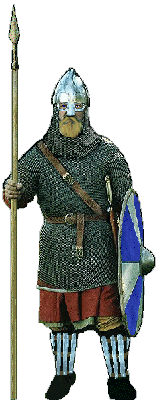


The Viking Age is the period from 793 AD to 1066 AD in European history, especially Northern European and Scandinavian history, following the Germanic Iron Age. It is the period of history when Scandinavian Norsemen explored Europe by its seas and rivers for trade, raids and conquest. In this period, the Vikings also settled in Norse Greenland, Newfoundland, and present-day Faroe Islands, Iceland, Normandy, Scotland, Ukraine, Ireland, Russia and Anatolia. Though Viking travelers and colonists were seen at many points in history as brutal raiders, some historical documents suggest that their invasion of other countries was motivated by overpopulation, trade inequities, and the lack of viable farmland in their homeland. Information about the Viking Age is drawn largely from primary sources of archaeology, supplied with secondary sources like the Icelandic Sagas.
Vikings (from Old Norse víkingr) were Germanic Norse seafarers, speaking the Old Norse language, who raided and traded from their Scandinavian homelands across wide areas of northern and central Europe, as well as European Russia, during the late 8th to late 11th centuries. The term is also commonly extended in modern English and other vernaculars to the inhabitants of Viking home communities during what has become known as the Viking Age. This period of Norse military, mercantile and demographic expansion constitutes an important element in the early medieval history of Scandinavia, the British Isles, France, Kievan Rus' and Sicily.
Facilitated by advanced seafaring skills, and characterized by the longship, Viking activities at times also extended into the Mediterranean littoral, North Africa, the Middle East and Central Asia. Following extended phases of (primarily sea- or river-borne) exploration, expansion and settlement, Viking (Norse) communities and polities were established in diverse areas of north-western Europe, European Russia, the North Atlantic islands and as far as the north-eastern coast of North America. This period of expansion witnessed the wider dissemination of Norse culture, while simultaneously introducing strong foreign cultural influences into Scandinavia itself, with profound developmental implications in both directions.
Popular, modern conceptions of the Vikings - the term frequently applied casually to their modern descendants and the inhabitants of modern Scandinavia - often strongly differ from the complex picture that emerges from archaeology and historical sources. A romanticized picture of Vikings as noble savages began to emerge in the 18th century; this developed and became widely propagated during the 19th-century Viking revival. Received views of the Vikings as alternatively violent, piratical heathens or as intrepid adventurers owe much to conflicting varieties of the modern Viking myth that had taken shape by the early 20th century.
The etymology of "Viking" is somewhat unclear. One path might be from the Old Norse word, vík, meaning "bay," "creek," or "inlet," and the suffix -ing, meaning "coming from" or "belonging to." Thus, viking would be a 'person of the bay', or "bayling" for lack of a better word. In Old Norse, this would be spelled vikingr. Later on, the term, viking, became synonymous with "naval expedition" or "naval raid, and a vikingr was a member of such expeditions. A second etymology suggested that the term is derived from Old English, wíc, ie. "trading city" (cognate to Latin vicus, "village").
The word viking appears on several rune stones found in Scandinavia. In the Icelandic sagas, víking refers to an overseas expedition (Old Norse farar i vikingr "to go on an expedition"), and víkingr, to a seaman or warrior taking part in such an expedition. In Old English, the word wicing appears first in the 6th or 7th century in the Anglo-Saxon poem, 'Widsith.'
In medieval use (eg. Widsith, and the writings of Adam von Bremen), a viking is a pirate, and not a name for the people or culture in general. Indeed, when Scandinavian raiders left their boats, stole horses and rode across country, they were never referred to as "vikings" in English sources.
The word disappeared in Middle English, and was reintroduced as viking during 18th century Romanticism. During the 20th century, the meaning of the term was expanded to refer not only to the raiders, but also to the entire period; it is now, somewhat confusingly, used as a noun both in the original meaning of raiders, warriors or navigators, and sometimes to refer to the Scandinavian population in general. As an adjective, the word is used in expressions like "Viking age," "Viking culture," "Viking colony," etc., generally referring to medieval Scandinavia.
During the last century, speculations began about whether foreign traders, known as varyags who had trade posts along the Russian rivers down to the Byzantine Empire were of Scandinavian origin, and since then, the term has been interpreted also to refer to tradesmen from Scandinavia who established colonies in Russia. Early Scandinavian colonies in North America are also labelled as "Viking" by modern English speakers.
It should be noted, however, that no written sources, in the cases of Vinland, Rus', or Varyags, use the term "Viking."Scandinavians, in general, were not Vikings. They were farmers, fishers and hunters, as were most other people in Europe at the time. As the Scandinavian shores were attacked by enemy forces, they established the defence fleet called leidang, which was also used as protection against Vikings.
Though a common practice today, calling all northmen (Scandinavians) Vikings, rather than reserving the word solely for those involved in piracy, can lead to misunderstanding and confusion. As members of the leidang fleet, as well as farmers and fishers now and then, were attacked by Vikings, most Scandinavians probably saw Vikings as their enemies and fought against them with all their might.
The earliest date given for a Viking raid is 787 AD when, according to the Anglo-Saxon Chronicle, a group of men from Norway sailed to Portland, in Dorset. There, they were mistaken for merchants by a royal official, and they murdered him when he tried to get them to accompany him to the king's manor to pay a trading tax on their goods. The next recorded attack, dated June 8, 793 AD, was on the monastery at Lindisfarne – the "Holy Island" – on the east coast of England. For the next 200 years, European history is filled with tales of Vikings and their plundering.
However, the vast majority of the Viking attacks were naturally attacks on France – as we know from the official histories – because the Emperor Charlemagne was seen as the main enemy, but other parts of the Holy Roman Empire also fell victim to such attacks as well as other Christian countries in Europe.
Vikings exerted influence throughout the coastal areas of Ireland and Scotland, and conquered and colonized large parts of England (see Danelaw). They travelled up the rivers of France and Spain, and gained control of areas in Russia and along the Baltic coast. Stories tell of raids in the Mediterranean and as far east as the Caspian Sea.
Adam of Bremen records in his book Gesta Hammaburgensis Ecclesiae Pontificum "There is much gold here (in Zealand), accumulated by piracy. These pirates, which are called wichingi by their own people, and Ascomanni by our own people, pay tribute to the Danish king."
�
Icelandic sagas Norse mythology, Norse sagas and Old Norse literature tell us about their religion through tales of heroic and mythological heroes. However, the transmission of this information was primarily oral, and we are reliant upon the writings of (later) Christian scholars, such as the Icelander Snorri Sturluson for much of this. An overwhelming amount of the sagas were written in Iceland. Vikings in those sagas are described as if they often struck at accessible and poorly defended targets, usually with impunity. The sagas state that the Vikings built settlements and were skilled craftsmen and traders.Rune Stones - Many rune stones in Scandinavia record the names of participants in Viking expeditions. Other rune stones mention men who died on Viking expeditions, among them the around 25 Ingvar stones in the Malardalen district of Sweden erected to commemorate members of a disastrous expedition into present-day Russia in the early 11th century. The rune stones are important sources in the study of the entire norse society and early medieval Scandinavia, not only of the viking segment of the population.
King Harald I of Norway finally was forced to make an expedition to the west to clear the islands and Scottish mainland of Vikings. Numbers of them fled to Iceland and the Faroe Islands, but the Norse sagas are rather subjective in their descriptions, and hence the Vikings in those sagas are sometimes characterized as heroes, later shaping the attitude towards Vikings during the 18th century Romantic period. Still, in Scandinavia, Vikings were not seen as an accepted part of society. They may even have been considered outlaws - several sources name Vikings in association with Jomsborg or Julin, which, according to modern history, was a refugee center for Slavic pirates, as opposed to the descriptions in the Norse saga.
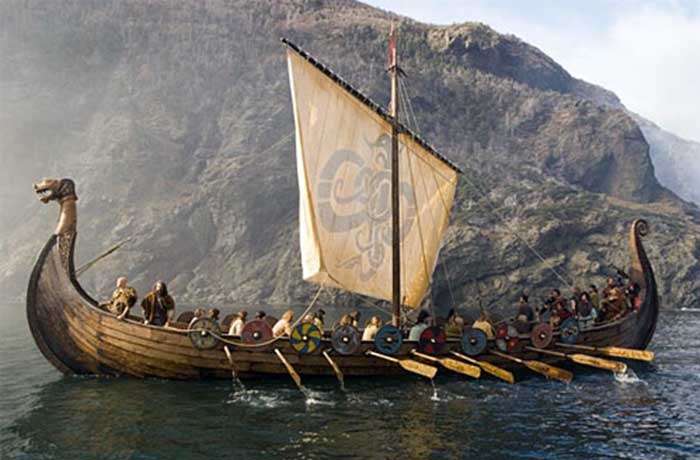
There were no specific "Viking ships" or "Viking longships"; Vikings used any of the common Scandinavian longships. These boats were identical to those used by the Scandinavian defense fleets, known as the ledung. The term "Viking ships" has entered common usage, however, possibly because of its Romantic associations. It is suspected that most Viking ships had an average length/width ratio of 4.5:1. Scholars also debate whether or not Vikings had cooking fires aboard their ships. There is no evidence connecting any discovered longship to any particular classical Viking raid. Nor has any "Viking" boat construction site, or harbor, been found or excavated. Thus, our knowledge of the actual boats Vikings used is limited.
The Viking Age is the name of the period between 793 and 1066 AD in Scandinavia and Britain, following the Germanic Iron Age (and the Vendel Age in Sweden).
During this period, the Vikings, Scandinavian warriors, leidangs and traders, raided and explored most parts of Europe, south-western Asia, northern Africa and north-eastern North America.
Apart from exploring Europe by way of its oceans and rivers with the aid of their advanced navigational skills and extending their trading routes across vast parts of the continent, they also engaged in warfare and looted and enslaved numerous Christian communities of Medieval Europe for centuries, contributing to the development of feudal systems in Europe, which included castles and barons (which were a defense against Viking raids).
Viking society was based on agriculture and trade with other peoples and placed great emphasis on the concept of honor both in combat and in the criminal justice system.
It is unknown what triggered the Vikings expansion and conquests, but historians have suggested that technological innovations imported from Mediterranean civilizations along with a milder climate led to population growth due to a long period of good crops. Another factor was the destruction of the Frisian fleet by Charlemagne around 785, which interrupted the flow of many trading goods from Central Europe to Scandinavia and led the Vikings to come looking for it themselves.
The beginning of the Viking Age is commonly given as 793, when Vikings raided the important British island monastery of Lindisfarne (although a minor incursion was recorded in 787); and the end of the Viking Age is traditionally marked by the failed invasion of England, attempted by Harald Hardrade, who was defeated by the Saxon king Harold Godwinson (himself an Anglicised Viking), in 1066. Godwinson himself was next defeated that same year by another Viking descendant, William, Duke of Normandy (Normandy had itself been acquired by Vikings (Normans) in 911).
The clinker-built longships used by the Scandinavians were uniquely suited to both deep and shallow waters, and thus extended the reach of Norse raiders, traders and settlers not only along coastlines, but also along the major river valleys of north-western Europe. Rurik also expanded to the east, and founded the first Russian state, with a capital at Novgorod, (which means, "new city"). According to one author, the word "Rus" originally meant "Viking raider", as distinct from the native slavic peoples.
Other Norse people, particularly those from the area that is now modern-day Sweden, continued south on Russian rivers to the Black Sea and then on to Constantinople (which had been established in 667 B.C., and was re-named Constantinople in 330 A.D. by Constantine the Great). Whenever these viking ships would run aground in shallow waters, the Vikings would reportedly turn them on their sides and drag them across the land, into deeper waters.
France, "the Kingdom of the Franks" (a Germanic tribe who settled in Gaul, after the fall of the Roman Empire, and whose famous King was Charlemagne, who had re-united the Kingdom by 771), was particularly hard-hit by these raiders, who could sail down the Seine River with near impunity. The region now known as Normandy (after the Viking "Norsemen, men from the north") was profoundly disrupted during this period.
In 911, the French king, Charles the Simple, was able to make an agreement with the Viking warleader Hrolf Ganger, later called Rollo. Charles gave Hrolf the title of duke, and granted him and his followers possession of Normandy. In return, Hrolf swore fealty to Charles, converted to Christianity, and undertook to defend the northern region of France against the incursions of other Viking groups.
The results were, in a historical sense, rather ironic: several generations later, the Norman descendants of these Viking settlers not only thereafter identified themselves as French, but carried the French language, and their variant of the French culture into England in 1066, after the Norman Conquest, and became the ruling aristocracy of Anglo-Saxon England. These Norman Viking descendants, although converting to Christianity, maintained their warlike nature, and eventually adopted chivalry, which joined learning to fight on horseback (like their Moorish enemies in Spain) with becoming knights or "holy warriors" of the Cross. One of their pass-times was jousting, or tournaments of armored knights fighting with lances (the Celtic "lancia") on horse-back.
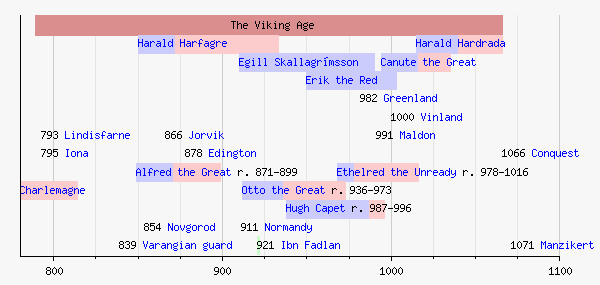
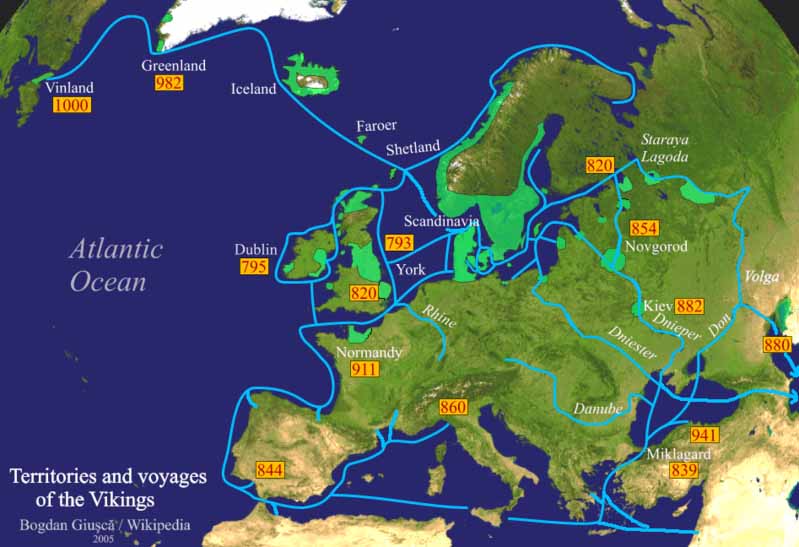
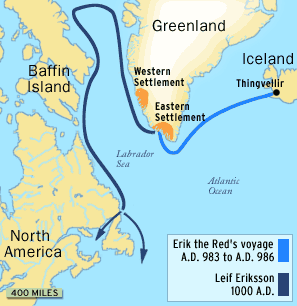
There are various theories concerning the causes of the Viking invasions. For people living along the coast, it would seem natural to seek new land by the sea. Another reason was that during this period England, Wales and Ireland, which were divided into many different warring kingdoms, were in internal disarray, and became easy prey. The Franks, however, had well-defended coasts, and heavily fortified ports and harbors. Pure thirst for adventure may also have been a factor. A reason for the raids is believed by some to be over-population caused by technological advances, such as the use of iron.
Although another cause could well have been pressure caused by the Frankish expansion to the south of Scandinavia, and their subsequent attacks upon the Viking peoples. Another possibly-contributing factor is that Harald I of Norway, ("Harald Fairhair") had united Norway around this time, and the bulk of the Vikings were displaced warriors who had been driven out of his kingdom, and who had nowhere to go. Consequently, these Vikings became raiders, in search of subsistence and bases to launch counter-raids against Harald. One theory that has been suggested is that the Vikings would plant crops after the winter, and go raiding as soon as the ice melted on the sea, then returned home with their loot, in time to harvest the crops, and to tell stories of their adventures. They became wandering raiders and mercenaries, like their Celtic cousins.
One important center of trade was at Hedeby. Close to the border with the Franks, it was effectively a crossroads between the cultures, until its eventual destruction by the Norwegians in an internecine dispute around the year 1050. York was the center of the kingdom of Jorvik from 866, and discoveries there show that Scandinavian trade connections in the 10th century reached beyond Byzantium (e.g. a silk cap, a counterfeit of a coin from Samarkand and a cowry shell from the Red Sea or the Persian Gulf), although they could be Byzantine imports, and there is no reason to assume that the Varangians themselves travelled significantly beyond Byzantium and the Caspian Sea.
The Danes sailed south, to Frisia, France and the southern parts of England. In the years 1013-1016 Canute the Great succeeded to the English throne.
According to the Anglo-Saxon Chronicles, after Lindisfarne was raided in 793, Vikings continued on small-scale raids across England. In 865 a larger army, supposedly led by Ivar, Halfdan and Guthrum (and other 'landless' kings) arrived in East Anglia. They proceeded to cross England into Northumbria, where some settled as farmers. Most of the English kingdoms, being in turmoil, could not stand against the Vikings. However, Alfred of Wessex managed to keep the Vikings out of his country. Alfred and his successors continued to drive back the Viking frontier. A new wave of Vikings appeared in England in 947 when Erik Bloodaxe captured York.
The Viking presence continued through the reign of Canute (1016-1035), after which a series of inheritance arguments weakened the family reign. The Viking presence dwindled until 1066, when the Danes lost their final battle with the English. See also Danelaw.
The Vikings conducted extensive raids in Ireland and founded a few towns, including Dublin. At some points, they seemingly came close to taking over the whole isle; however, the Vikings and Scandinavians settled down and intermixed with the Irish. One of the last major battles involving Vikings was the Battle of Clontarf in 1014, in which Vikings fought both for High King Brian Boru's army and for the Viking-led army opposing the High King. The Normans invaded Ireland in 1172.
The Norwegians traveled to the north-west and west, founding vibrant communities in the Faroe Islands, the Shetlands, the Orkneys, Iceland, Ireland and Great Britain. Apart from Britain and Ireland, Norwegians mostly found largely uninhabited land, and established settlements in those places.
According to the sagas of Erik the Red, and Leif Eriksson, the Vikings named the an island in the North Atlantic "Iceland". When Erik the Red was exiled from Iceland he went west. There he found a land that he named "Greenland" to attract people from Iceland to settle it with him.
The Viking Age settlements in Greenland were established in the sheltered fjords of the southern and western coast. They settled in three separate areas along approximately 650 kilometers of the western coast.
�The Swedish Varangians sailed east into Russia, where Rurik founded the first Russian state at Novgorod and on the rivers south to the Black Sea, Miklagard (Constantinople) and the Byzantine Empire.
�In about the year 986 A.D., North America was reached by Bjarni Herjolfsson.
Leif Ericsson and Karlsefni from Greenland attempted to settle the land, which they dubbed Vinland about the year 1000 A.D. A small settlement was placed on the northern peninsula of Newfoundland, near L'Anse aux Meadows, but previous inhabitants, and a cold climate brought it to an end within a few years.
The archaeological remains are now a UN World Heritage Site. It has now been scientifically established that at the height of the Scandinavian expansion, the northern hemisphere entered into a period of unusual, and long-lasting cold, which continued for several hundred years. This miniature ice-age decimated the Greenland colonies, hampered the Scandinavian homelands and stopped further westward expansion. Also, around this time, a plague broke out in Europe, which decimated the population, and also stopped westward expansion into America. The Viking out-post in Iceland was reportedly left without supplies, and cut off from reinforcements.
The Vikings were equipped with the then technologically superior longships; for purposes of conducting trade, however, another type of ship, the knarr, wider and deeper in draught, were customarily used. The Vikings were competent sailors, adept in land warfare as well as at sea, and they often struck at accessible and poorly-defended targets, usually with near impunity. It is the effectiveness of these tactics that earned them their formidable reputation as raiders and pirates, and the chroniclers paid little attention to other aspects of medieval Scandinavian culture.
This is further accentuated by the absence of contemporary primary source documentation from within the Viking Age communities themselves, and little documentary evidence is available until later, when Christian sources begin to contribute. It is only over time, as historians and archaeologists have begun to challenge the one-sided descriptions of the chroniclers, that a more balanced picture of the Norsemen has begun to become apparent.
Besides allowing the Vikings to travel vast distances, their longships gave them certain tactical advantages in battle. They could perform very efficient hit-and-run attacks, in which they approached quickly and unexpectedly, then left before a counter-offensive could be launched. Because of their negligible draught, longships could sail in shallow waters, allowing the Vikings to travel far inland along the rivers. Their speed was also prodigious for the time, estimated at a maximum of 14 or 15 knots.
The use of the longships ended when technology changed, and ships began to be constructed using saws instead of axes. This led to a lesser quality of ships; and, together with an increasing centralisation of government in the Scandinavian countries, the old system of Leidang -- a fleet mobilization system, where every Skipen (ship community) had to deliver one ship and crew -- was discontinued. Shipbuilding in the rest of Europe also led to the demise of the longship for military purposes. By the 11th and 12th centuries, fighting ships began to be built with raised platforms fore and aft, from which archers could shoot down into the relatively low longships.
There is an archeological find in Sweden of a bone fraction that has been fixated with in-operated material; the piece is as yet undated. These bones might possibly be the remains of a trader from the Middle East.
The nautical achievements of the Vikings were quite exceptional. For instance, they made distance tables for sea voyages that were so exact, that they only differ 2-4% from modern satellite measurements, even on long distances, such as across the Atlantic Ocean.
There is a finding at the island of Gotland in Sweden that might possibly be components from a telescope, although the "telescope" was invented in the 1600's.
The Vikings adhered to a system of beliefs they called Asatru. Their pantheon of gods and goddesses included their belief in Valhalla, or "Heaven for Warriors" (which partly explains their war-like nature). According to Viking beliefs, valorous Viking chieftains would please their war-gods by their bravery, and would become "worth-ship"; that is, the chieftain would earn a "burial at sea", or a burial on land, which may have included a ship, treasure, weapons, tools, clothing and even live slaves and women buried alive with the dead chieftain, for his "journey to Valhalla, and adventure and pleasure in the after-life".
Then, living sages would compose sagas about the exploits of these chieftains, keeping their memories alive on earth as well (a different kind of "immortality"). These sometimes vast, often rich burial mounds have been found extensively through-out the regions visited by the Vikings, and have provided archaelogists with rich material about the Vikings (who apparently were illiterate themselves; their stories were passed down by oral tradition, until the Christian monks and other clergy wrote them down).
According to Joel Supéry, the French author of 'Le Secret des Vikings', the Scandinavian attacks against the Frankish Empire were carried out not by raiding adventurers looking for gold and silver but by armies applying a military strategy.
In 795 AD, long before the start of the Danish invasion proper in 840, Scandinavians were present in Asturias, on the northern shore of Spain, where they fought with the local king against the Moors.
In 799, the Franks attacked them in Noirmoutier; in 812, a Viking fleet was seen off Perpignan on the Mediterranean Sea. In 816, Northmen were in Pamplona fighting together with a Navarrese army against the Moors. In 823 and 825, their presence was recorded on the Ria Mundaka in Biscaya. According to Supery, the intention of these Vikings was to create a commercial route to the Mediterranean Sea, then the centre of the world's trade.The main western European trading route between the south and the north was the Rhine-Rhone axis.
The Franks initiated a form of commercial blockade in an effort to weaken the Danish kingdom. The Danes therefore decided to create their own route to the south along the Frankish coast. On this route they met the Moors, who were the masters of the Strait of Gibraltar.
As this course was deemed too risky, they decided to reach the oriental markets by crossing the Pyrenees, passing through Mundaka (Guernika), Pamplona and then Tortosa, which was the main slave market in Europe.In 840, the Danes began their attacks on the Frankish Empire – not on the Seine but on the Adour. Gascony fell under their complete control as early as 844. The leader of the invasion, Bjorn Ironside, became the ruler of the area and gave his name to Bayonne (originally "Björnhamn").
Hastein had occupied Noirmoutier in 843.
In 845 Asgeir began to settle in Saintonge in Aquitania. Effectively, by 845 all the lands around the Bay of Biscay were under Danish control.
The Danish war in the north of France began with two objectives: to weaken the power of King Charles the Bald and to prevent the Franks from attacking in the south. In 858, having crushed the Frankish kingdom, Bjorn concluded a treaty with Charles the Bald whereby - according to Supery - the Danes were formally granted all the country south of the river Garonne, an area which was thereafter no longer mentioned in the Frankish annals.
In the following year, Bjorn forced the king of Navarre to make a treaty allowing the Danes to cross Navarre to reach the river Ebro and Tortosa. He then sailed with Hastein to the Mediterranean Sea.
While Hastein set about disorganizing trade in the Rhine valley and Italy, Bjorn attacked Constantinople, after joining up with the Swedish Varyags who had come across Russia. He obtained a commercial treaty from the Byzantine Emperor intended to attract trade away from the Rhone to the Ebro.
In 863, Dorestad in Frisia, the Franks' main commercial centre on the Rhine, was definitively destroyed. The first Viking war was over: the Danes had set up a new trade network in place of an older and opposing one.Then a new war began: the Danish chiefs tried to emulate the success of Bjorn in Gascony and to create their own overseas kingdoms. Northumbria, Mercia, Frisia, Aquitaine, Bretagne and Normandy were all affected by these attempts to found Scandinavian settlements.
Gascony stayed under the Vikings' control for 140 years. Their army was finally defeated in 982 by forces from Gascony, Perigord and Navarre. The Gascons of Nordic origin were allowed to stay in the country which had become rich under their rule, but they were condemned not to mix with other communities, becoming (according to one legend) the despised and ostracized Agotes or Cagots.
Yet their continuing presence in the Biscay area may help to explain why the Basques have so many traditions (such as whale hunting) with possible Nordic origins, and perhaps why they are said to have reached America one hundred years before Christopher Colombus.
ANCIENT AND LOST CIVILIZATIONS